I suppose salad doesn’t leap into most people’s minds at the sight of a field turned hazy purple with a carpet of wild woodland violets. But if you live anywhere that these beautiful ephemerals appear each spring, a gorgeous violet salad is yours just for the picking. It’s also a simple matter to create a quick violet vinaigrette that’s great over greens. This vinaigrette dressing is not only colorful, but adds vitamins A and C to your meal.
The flavor of violets is delicate, so they are actually suitable for garnishing both savory and sweet dishes. The texture of the fresh petals is reminiscent of the very tenderest, mildest baby lettuce. And, they are not merely decorative–in addition to the vitamins they contain healthful antioxidents.
All varieties of true violets, or Violas, are edible (and equally lovely strewn over a salad) and nearly all in America cease flowering by early June. However, do keep in mind that native violets are not the same as African violets, which are not native woodland plants and are not edible.
Be sure not to dawdle if you want to take advantage of this spring’s violet crop: In much of the country the blooms of members of the large Violaceae family–from purple to lavender blue to yellow, to cream and white–suddenly pop up along walking paths and in vacant lots and naturalized gardens in early April. Actually, most of the scented ‘oderata’ European violets I planted in my yard bloom in March!
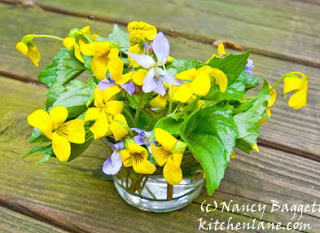 Hundreds of kinds of violets are native to the United States, and experts say they hybridize readily, so identifying them is tricky. I tried but quickly realized this task should be left to a botanist! Not only are their colors varied, but subtle differences in throat markings and overall bloom shape have to be taken into account. Look closely, and you’ll see that the petals of the pale lavender violet at right are slightly more angular than those of the deeper purple ones pictured below.
Hundreds of kinds of violets are native to the United States, and experts say they hybridize readily, so identifying them is tricky. I tried but quickly realized this task should be left to a botanist! Not only are their colors varied, but subtle differences in throat markings and overall bloom shape have to be taken into account. Look closely, and you’ll see that the petals of the pale lavender violet at right are slightly more angular than those of the deeper purple ones pictured below.
As you might have guessed, violets thrive here in central Maryland. So I not only use them to garnish salads but sometimes in light, quick dressings for them.
It’s best to add the violets to your salad right before serving, as most varieties will begin to wilt within a half hour. (The yellow ones are especially fragile and will droop in just a few minutes.) You can garnish both tossed and composed salads with equal success.
Be sure to wash fresh violets thoroughly under gently running water. Gently pat dry on paper towels. Use them abundantly to make a big splash!
Feel free to use whatever greens you prefer. The light taste of spinach, baby romaine, and oak leaf lettuce do make them an excellent choice, as they marry well with this mild oil and vinegar dressing. Plus, their leaves contrast nicely with violets on all colors.
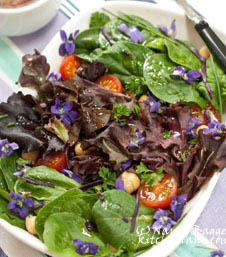 To streamline this homemade vinaigrette dressing recipe, I rely on a ready-to-use seasoned (salt and sugar added) rice vinegar. I especially like the Nakano brand version labeled “All-Natural-Original.” It’s zesty yet smooth and
To streamline this homemade vinaigrette dressing recipe, I rely on a ready-to-use seasoned (salt and sugar added) rice vinegar. I especially like the Nakano brand version labeled “All-Natural-Original.” It’s zesty yet smooth andbalances the olive oil nicely. The choices seasoned with garlic seem a bit too strong. If the violet petals whisked into the dressing happen to be blue or purple, you’ll soon notice that they are turning a pretty pinkish red shade. That’s because the anthocyanin pigments (antioxidants also responsible for the color in vegetables like red cabbage) change in the presence of the acid in the vinegar.
Violet Vinaigrette
1/3 cup seasoned rice vinegar (preferably Nakano original)\
About 1 tablespoon chopped fresh violet petals
In a deep, medium-sized, non-reactive bowl, whisk together the rice vinegar, chopped violets, chives, sugar, mustard powder, salt and pepper. Gradually whisk in the oil until incorporated. Taste and add more salt and pepper, if desired. Let the vinaigrette stand a least 20 minutes and preferably an hour at room temperature before serving to allow the flavors to mingle. (If preferred, store the dressing airtight and refrigerated in a jar or non-reactive container for up to a week. Let return to room temperature before using.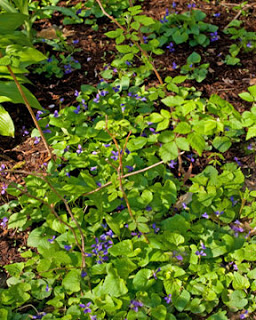
At serving time, whisk, stir vigorously, or shake the dressing well before tossing with greens or drizzling over a salad. Makes 2/3 cup dressing.
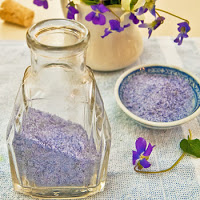
Perhaps you might also like my violet decorating sugar recipe here.
Or a violet syrup recipe here.

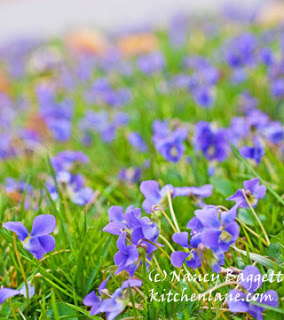


Yes, very true. A nice way to dress up a salad for a Mother's Day meal. BTW, if you happen to have them in your area, white and yellow violets look pretty, too.
Love this–so easy to make a fancy, really special salad without any trouble at all.